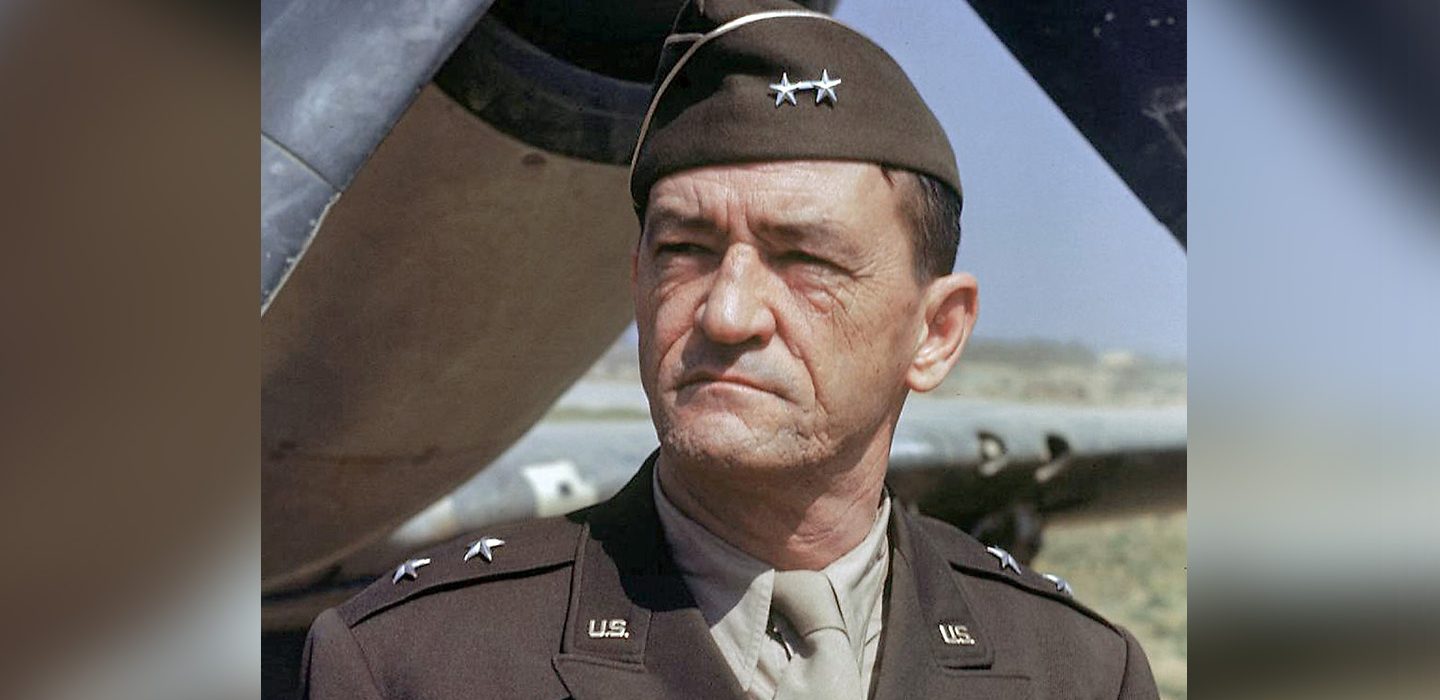A “Tiger” who showed his teeth without biting his tongue.
Chennault was a well-known and heroic figure in America during World War II, due largely to his command of the Flying Tigers in China. The American Volunteer Group—its official name—suited Chennault and his personality.
Raised in Louisiana, Chennault attended LSU for a year but dropped out due to lack of money. When the U.S. went to war in 1917, he enlisted in the Army, went to officer school, and then flying training. He did not fly in France, but over the next 17 years he earned a reputation as an outstanding pursuiter—fighter pilot—as well as an irascible and difficult officer. In 1930 he was sent to the Air Corps Tactical School to head the Pursuit Section.
Chennault’s ideas on the superiority of pursuit aircraft were contrary to those of his colleagues at the Tactical School. There, the theory of strategic bombing was taking hold, and this theory assumed that nothing could stop a well-organized bomber attack from penetrating enemy airspace and destroying a nation’s key manufacturing, transportation, and military targets. Chennault begged to differ. He argued, strenuously, that fighters could intercept a bomber formation and decimate it before it could reach its targets—and this was before the invention of radar, which would make his argument even stronger.
His personality was both his greatest strength and greatest weakness—not unusual for original thinkers—and his abrasive and aggressive attitude alienated his coworkers. This was unfortunate because his warnings should have been heeded—the war would show the theory of unescorted bomber formations was wrong.
Surprisingly, however, although Chennault was convinced his planes could find, intercept and stop an attacking bomber formation, he refused to take the next step. He rejected the idea of providing escort to the bombers. To him, that smacked of a passive and defensive mindset. A fighter pilot’s primary trait was aggressiveness, and he did not want it wasted on the reactive mission of escort. He was not alone in this attitude—many other pursuit pilots thought similarly. This too was a shortcoming that would soon become evident in combat.
Plagued with a variety of physical ailments, besides being burdened with a difficult personality, it was obvious to Chennault that he had no future in the Air Corps. In 1937 he retired as a major. Fate then intervened.
China had been invaded by Japan and was in desperate straits. Chiang Kai-Shek reached out to America for help. President Franklin Roosevelt was reluctant to buck the prevailing isolationist sentiments across the U.S., but did extend some assistance. He agreed to sell the Chinese 100 fighter aircraft, Curtis P-40 Warhawks. Chiang had already hired Chennault to head his nascent air force, and Roosevelt allowed military pilots to be recruited to fly in this air arm. Those attracted to the Soldier-of-fortune job of flying for China, under the command of Chennault, were of a type.
Like Chennault himself, most of those recruited for his Volunteer Group were hard, aggressive men who did not get along and whose units were happy to be rid of them.
The P-40 was inferior to the front line Japanese fighter, the Zero, and Chennault knew it. He flew dozens of combat missions against the Japanese himself, reputedly shooting down dozens of enemy aircraft, and quickly learned the tactics needed to fight the Zeros and survive: “always look around, stay together, hit and get out so you can recover speed and come back, withdraw erratically so the enemy cannot anticipate your vulnerable moments. Concentrate your force where the enemy is weakest; do not let him use his strength against you and make the most of every advantage you have. Use your wits; know your ship and your enemy.”
The results were exceptional. The Flying Tigers—named because the pilots painted graphic shark teeth and eyes on their aircraft noses—proved a match for the Japanese. During their limited time in action they shot down nearly 300 Japanese aircraft for a loss of only 12 of their own. When the U.S. entered the war, the Tigers were inducted into the new 14th Air Force, and Chennault, brought back on Active duty and promoted to major general, became its commander.
Chennault did not get along with his superior, Lt. Gen. Joe Stillwell, nor with his air superiors either, in theater or in Washington—Henry “Hap” Arnold thought him a “crackpot.” When the war ended, he was quickly hustled back into retirement. He remained in China and formed Civil Air Transport—it would soon be bought by the CIA and renamed Air America. Chennault was belatedly promoted to lieutenant general nine days before he died in July 1958.
Chennault’s memoirs, “Way of a Fighter” (Putnam’s, 1949) are like the man himself, egotistical and contentious, but always interesting. There are several biographies of the general, but the two best are “Chennault: Giving Wings to the Tiger” (University of Alabama Press, 1987), and “Jack Sampson’s Chennault” (Doubleday, 1987).
